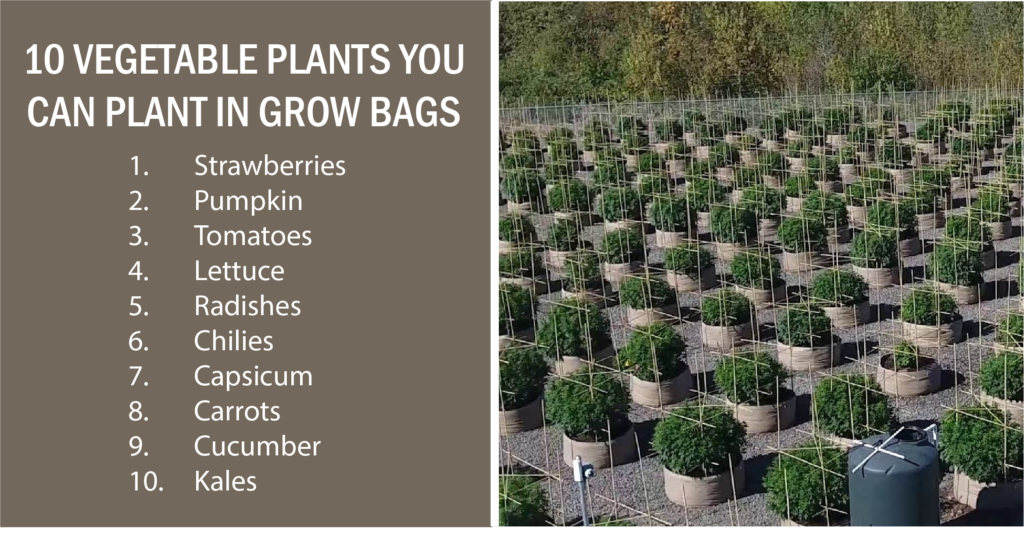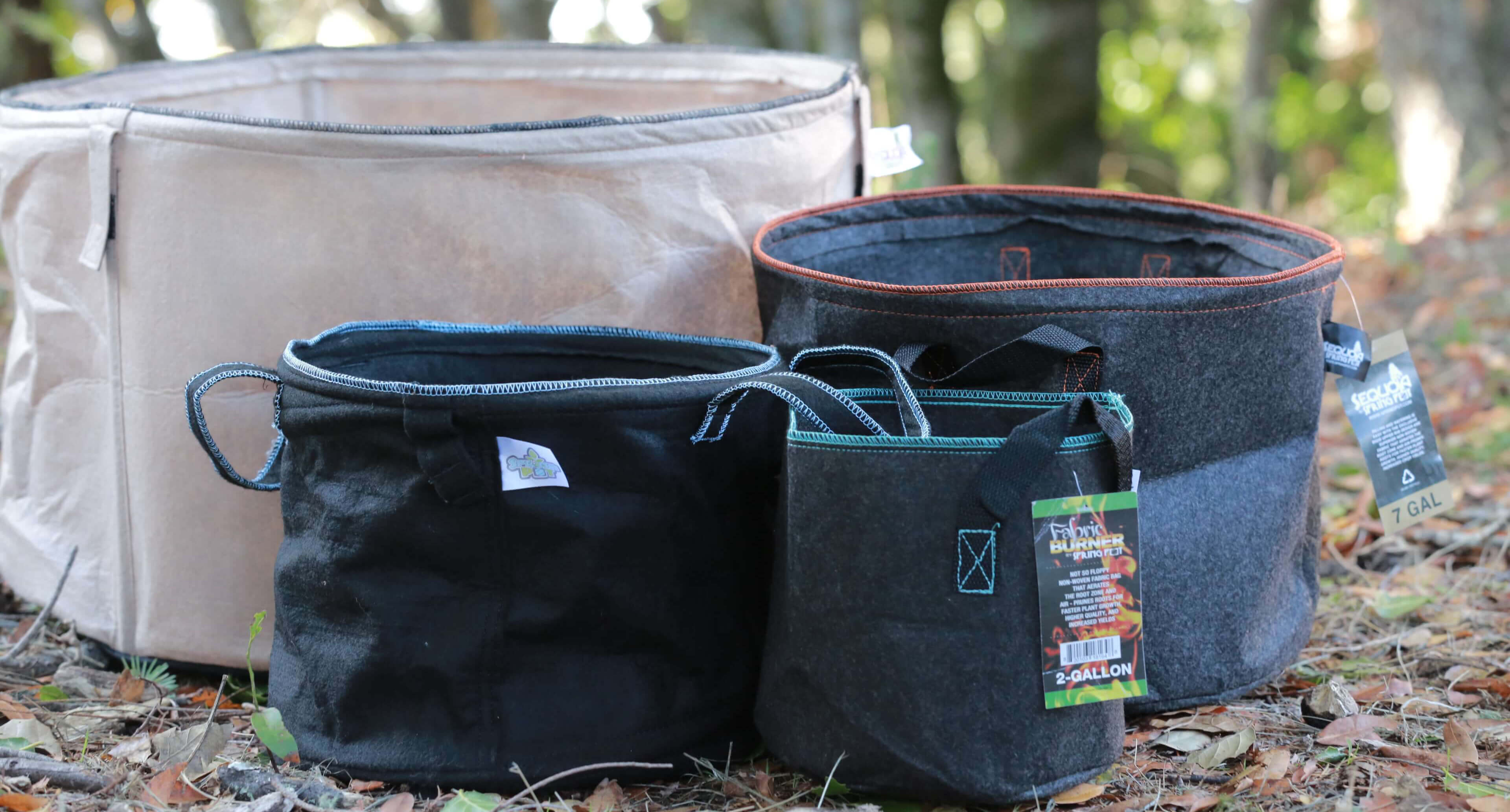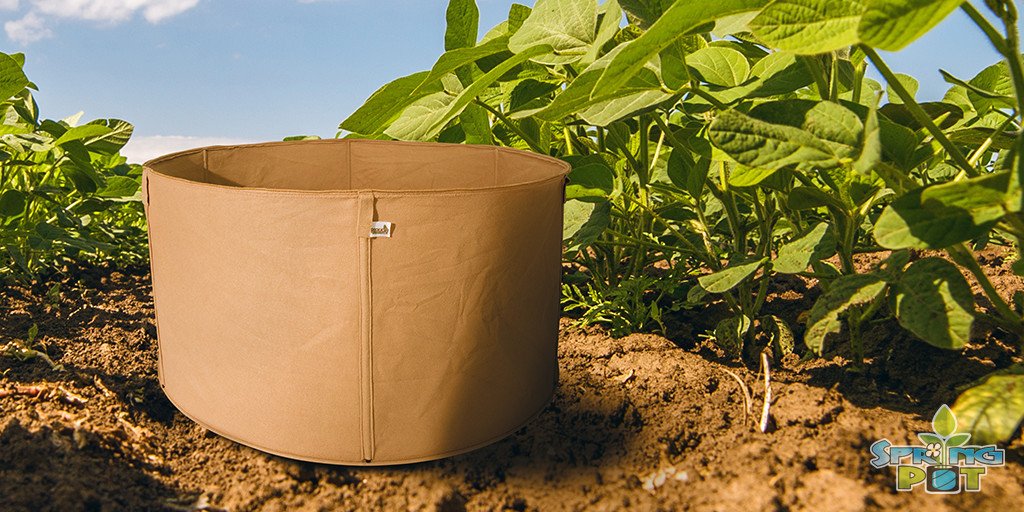Fabric Grow Bags: Complete Guide to Fabric Pots (2019)
Fabric Grow Bags: Complete Guide to Fabric Pots (2019)
WHAT ARE FABRIC GROW BAGS?
Fabric grow bags are just what they sound like – a bag that you can grow plants in. They are made from a thick breathable fabric, similar to a reusable grocery bag. Grow bags are well aerated and have superior drainage over traditional plastic pots. Fabric Grow bags are usually filled with a growing medium, which can range from soil to soilless materials like peat, composted green waste, bark or wood chips, or any mixture of these items. Grow bags come in various heights and widths which make them versatile enough to accommodate almost any size plant. They are very adaptable and are easily arranged and re-arranged as needed. Improved root systems and better temperature and watering control are a couple of other benefits of using grow bags.
 Typically, grow bags, or fabric pots as they are often called, are used to grow various vegetables and even plants such as small to medium-sized trees. They are ideal for any plants that have small root structures. Nutrients, such as nitrogen, are added to last the growing season which means only watering is required from the grower. Grow bags are the perfect solution when you have limited space or poor soil conditions. There are a few different brands on the market, each having its own pros and cons.
Typically, grow bags, or fabric pots as they are often called, are used to grow various vegetables and even plants such as small to medium-sized trees. They are ideal for any plants that have small root structures. Nutrients, such as nitrogen, are added to last the growing season which means only watering is required from the grower. Grow bags are the perfect solution when you have limited space or poor soil conditions. There are a few different brands on the market, each having its own pros and cons.
Grow bags can be used to create the illusion of a raised flower bed by placing a series of bags side by side in a rectangle shape. But unlike traditional raised garden beds, fabric pots require no construction and can be shaped and re-shaped as needed. Make a last-minute change to your layout and its no problem, just move you grow bags into the shape you like. You can start your plants indoors or outdoors, reposition them for changing light conditions, and they can be placed anywhere you want. Grow bags take up less space when not in use and be stored inside by simply folding them up and putting them away until needed.
 BRIEF HISTORY OF GROW BAGS
BRIEF HISTORY OF GROW BAGS
Although grow bags were first manufactured for use at home in the 1970s, they quickly evolved into use in more commercial applications such as market gardens
Before fabric bags, the greenhouse soil had to either be replaced or sterilized in between seasons to prevent diseases and pest from taking hold of the soil. Commercial growers would have to steam and sterilize their ground. At the end of the season, the plants were disposed of and the compost spread over outdoor borders.
This method was not feasible for beginner gardeners or those with small gardens. This is when grow bags were introduced to support the more amateur gardener’s needs.
WHY USE GROW BAGS FOR GARDENING?
Superior Drainage
Grow bags are made of breathable fabric which provides superior drainage and aeration. It is the aeration that makes them preferable to most other garden containers. When a container has no aeration, the roots grow out until they reach the walls of the container. Once this occurs the roots signal the plant to make more roots which results in a root bound plant. Eventually, the plant smothers itself with a mass of roots going that fill up the container.
Healthier Plant Roots
Root bounding does not occur with grow bags. Instead when the roots reach the wall so the grow bag they are burned off, which causes the plant to produce new healthy roots that branch off the original ones. This is known as “air-pruning”. In pots, the roots of the plants tend to grow in circles entangling themselves. This increases the likelihood of having oxygenation or water stagnation issues, especially in larger pots that lack proper drainage.
 When the roots reach the edge of a plastic pot, they continue growing in search of more water and nutrients only to begin encircling the pot. This begins the process of structural damage to your plants. The roots become constricted leading to less water and nutrient intake. The stem of your plant will also become compressed which leads to tissue damage further restricting nutrient intake.
When the roots reach the edge of a plastic pot, they continue growing in search of more water and nutrients only to begin encircling the pot. This begins the process of structural damage to your plants. The roots become constricted leading to less water and nutrient intake. The stem of your plant will also become compressed which leads to tissue damage further restricting nutrient intake.
Fabric grow bags help to alleviate this issue because as the roots meet the edges of the fabric pot, they sense the drier soil that is exposed to the air. At this point, they know they have reached their growth limit. The roots become “air pruned” which is vital to growing healthy plants in containers. This prevents overgrowth of roots eliminating girdling roots (roots that damage the structure of the plant).
You will also get many more fibrous roots when air pruned. A more fibrous root system (many small root tips) allows the plants to take in more nutrients and water. Plastic potted plants encourage a few large roots to dominate and encircle the pot which constricts nutrient uptake.
 Temperature Control
Temperature Control
During the heat of summer and in direct sunlight plastic pots can get quite hot. Since they are not breathable, they trap all the heat which can cook your plants. Fabric bags regulate temperature due to their breathable quality. Excess heat can escape from all sides of the grow bag.
Storage
Where do you store the pots when not in use? Do they become empty eyesores on the back porch or stacked up in the shed in hopes they don’t get crushed or broken in the offseason? Traditional pots will need to be stacked for storage in the offseason. However, grow bags can be folded up and stored with minimal space each season.
Versatility
Grow bags are lightweight and usually come with built-in handles making them easy to move to different locations. They are popular among Rv’ers since the can be brought from inside to out with ease and they take up minimal space when storing.
 BENEFITS OF GARDENING WITH FABRIC POTS
BENEFITS OF GARDENING WITH FABRIC POTS
The pros outweigh the cons when it comes to grow bags and fabric pots. Fabric bags are constructed from a breathable material which allows for the air pruning we just mentioned to occur. As the roots reach the sides of the fabric pot, they are exposed to oxygen which kills off the root at the end. This allows for your plant to grow another root directly from the source.
With every root that grows the plant is strengthened and will grow more rapidly above the soil surface. By developing this root structure early one on it will increase the chance of the plant keeping its natural root structure when it comes time to replant.
Grow bags are much better at controlling the temperature and water content of your growing medium than traditional plastic pots. In the cold, the fabric will keep your plant warmer, and in the hot sun your plant will be kept cooler, so it doesn’t overheat. Although fabric bags may need more frequent watering, it’s because of the porous material which is less likely to hold in excess water as the old plastic pot materials do. The chance of root rot when using fabric bags if very slim.
HOW TO USE GROW BAGS FOR GARDENING?
If your garden is on a balcony then grow bags are the way to go. Grow bags allow you to grow food without a spec of land. Fabric Pots are also great for indoor gardens as well. You can grow carrots and tomatoes year-round!
Growing bags have been designed to minimize waste and support reuse. Whether you’re planning to use your bags indoors or outdoors, it’s important to learn how to use them. Here’s a detailed guide to help you learn how to use your growing bags to plant, care for, and nurture your plants.
SOIL FOR GROW BAGS
A good mix for grow bags is 1/3 moss, 1/3 compost mixture, and 1/3 vermiculite. This mix retains moisture and is very important for gardening with grow bags.
You can also mulch your grow bags with wood chips just like you would in the garden. This will help keep the soil moist on top and you will find that plants grow better with mulch.
You can reuse this soil mixture year after year with no problems. Just remove the wood chips, empty the bags, add 10-20% new compost, and mix it up well.
WATERING FABRIC POTS
Watering can be a challenging process with any garden. Too much water and it pools making the plants develop mould or fungus. Too little water and they dry out. Grow bags will tend to dry out a little faster than pots so be aware of that. This occurs because of the superior aeration and drainage inherent to the fabric bags. It might be tough to really soak a plant in a grow bag as the water will come right out.
In contrast, a traditional pot may need less watering, but it is easy to over water. If you over-water a plant in a traditional pot they could drown or develop mould or fungus.
Drip System
By installing a drip watering system, the grow bags will get a constant moisture supply. A pipe drip system works fairly well for this application.
Self-Watering System
Put a container underneath the grow bag and fill it with water so it can be wicked up by the plant as it needs it. Any container will work, even a kiddie pool. Be careful though, if the container is too deep, you will need an overflow. You want most of the roots to be in the air. Styrofoam can be shaped however you want then lined with polyethylene to make an interesting self-watering container.
FERTILIZING GROW BAGS
Obviously, fabric bags do not contain as much soil as the natural earth does. So heavy feeder plants will need to be fertilized. Bone meal, worm castings, and compost teas, all make great natural fertilizers. Epsom Salts and eggshells can help to add minerals. For real professional results, we suggest micro-biotic nutrients from Organitek.
GARDENING WITH FABRIC POTS
Grow bags are a perfect option you have very little room for an in-ground garden. They can be arranged any place that receives sunlight such as a porch or near a window. Fabric pots are also good if you have poor quality soil in your area. One nifty idea is to dump your used soil from your grow bag in an area where you hope to one-day plant a garden. After a few years of performing this, the soil quality will be greatly improved.
 BEST CHOICE FOR GARDENING WITH GROW BAGS
BEST CHOICE FOR GARDENING WITH GROW BAGS
Efficient gardening practices have been utilized in gardening for some time now. When the grow bags were first introduced in the ’70s, they were a new, better way to plant, and a better tool for transplanting than the old terra-cotta pots.
Grow bags come in different shapes and sizes according to your specific planting needs. Some fabric bags are specifically designed for growing potatoes with side openings for the perfect harvest. Others are better for strawberries with side pockets for planting in a stacked formation. Reusable bags can be folded and stored in small spaces during the offseason, without any worry of them breaking down in the off-season.
WHAT SIZE GROW BAG DO I USE?
3-gallon size fabric pot works well for a single plant like pepper, or a couple of plants such as lettuce or peas.
5-gallon grow bags work well for almost anything, particularly tomatoes, but peppers, flowers, herbs, potatoes, small fruiting trees, stevia will grow wonderfully in grow bags also.
10-gallon grow bags are quite large and can accommodate a whole garden in one container. You can easily grow potatoes or tomatoes with basil all around them. Spinach and salad greens are other big favourites.
And a bonus is that grow bags will outlast any plastic container provided they are stored properly in the off-season. Let us not forget to mention that fabric bags are better for the environment too!
If you like the idea of having a larger planting area similar to a raised bed you can also try out the 100 gallons grow bags. This gives you tons of room to grow many plants all within a single grow bag.
CONCLUSION
You can grow up to three plants in a single grow bag. Just make sure to prepare your bags properly for planting and sow the right plants for your specific fabric pot.
You should only buy high-quality grow bags from a reputable supplier such as Spring Pot to guarantee the durability of your bags and the success of your garden.


 BRIEF HISTORY OF GROW BAGS
BRIEF HISTORY OF GROW BAGS
 Temperature Control
Temperature Control BENEFITS OF GARDENING WITH FABRIC POTS
BENEFITS OF GARDENING WITH FABRIC POTS
 BEST CHOICE FOR GARDENING
BEST CHOICE FOR GARDENING 




